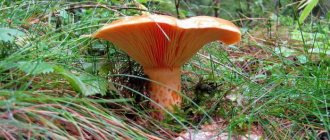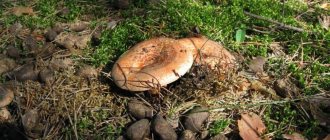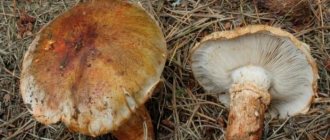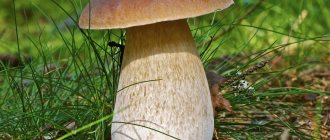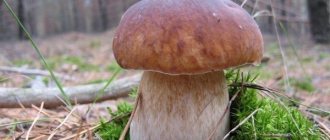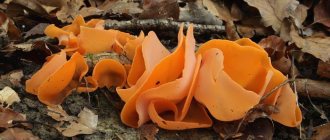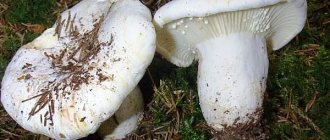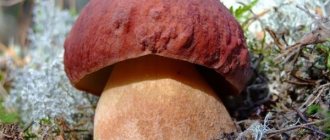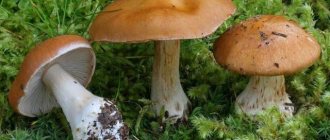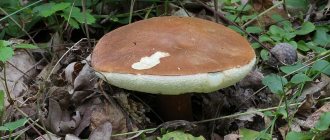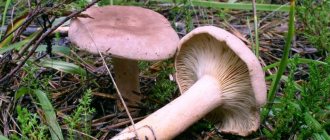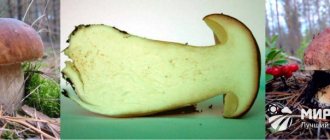Where does the spruce saffron grow?
Spruce trees can be found throughout central Russia, as well as in the Urals, the Far East and Siberia. As the name implies, fungi grow in spruce forests; they usually hide in grass and fallen pine needles under spruce trees and sometimes under junipers. Sometimes you can see spruce trees alone, but more often they are found in whole groups.
Green spruce saffron milk caps are considered late mushrooms; maximum fruiting occurs in September, and fungi can be found in the forest until frost.
Cooking methods
Agree, the name “saffron milk cap” has a lot of warmth and even affection. A beautiful and fragrant mushroom has become extremely popular in our country. We have listed the main species above, but, as a rule, the ones that most often end up in our baskets are pine saffron and spruce. Every mushroom picker should know how to cook them. Saffron milk caps of all stripes and sizes are harvested. However, those whose cap is slightly smaller in diameter than the neck of the bottle are considered a real delicacy. The main cooking methods are as follows.
- pickling (dry and cold);
- pickling;
- pickling;
- frying and cooking.
Let us dwell in more detail on the traditional methods of pickling saffron milk caps, which have been known since ancient times.
What does a spruce mushroom look like?
Spruce fungus can be recognized by its flat-concave cap, about 10 cm in diameter, with a dark red or light pink color. In young fungi, the cap is slightly convex, with downward-curved edges and a tubercle in the middle, but subsequently its shape gradually changes. A characteristic feature of the spruce saffron milk cap is the fragility of the cap and the absence of pubescence along the edges.
According to the photo and description of the spruce mushroom, its stem is small - only about 5 cm in height, shorter than that of a real mushroom. The shape of the stem is cylindrical; in young mushrooms it is solid, but in adults it is hollow from the inside and very brittle. The color of the leg is exactly the same as the cap, and also turns green if it is damaged.
When broken, the spruce fungus releases a bright orange milky sap that quickly turns green when exposed to air. The same applies to the orange pulp; it turns green when broken. The bottom of the spruce cap is covered with fragile thin plates of light orange color, turning green when pressed.
Taste qualities of mushroom
In terms of taste, spruce mushrooms belong to the prestigious 1st category of edible mushrooms. They have a pleasant taste and light fruity aroma when fresh.
Spruce fungi can be processed using almost all existing methods; they are not suitable only for drying. But they are salted, pickled, boiled and fried, and sometimes even eaten fresh, washed and sprinkled with salt.
Interesting Facts
- In the 19th and 20th centuries, spruce trees were used in folk medicine as an anti-tuberculosis agent.
- When cooking mushrooms, spices are often not used due to the milky juice.
- In the Russian Empire, salted spruce trees were imported to France as a delicacy and were valued more than champagne.
The good thing about collecting saffron milk caps is that they do not have poisonous counterparts and are suitable even for novice collectors. It is not difficult to find it in typical growing areas. Such a gift from the forest will be a great find for any mushroom picker.
Information sources
- Kibby J. Atlas of mushrooms: Key to species. - St. Petersburg: Amphora, 2009. - P. 184.
- Jansen P. Everything about mushrooms. - St. Petersburg: Crystal, 2006. - P. 84.
- Harding P. Mushrooms. - M.: AST, 2002. - P. 100.
- Mushrooms: Directory / Transl. from Italian F. Dvin. - M.: AST, 2001. - P. 129.
Benefits and harm to the body
When consumed, spruce saffron milk caps can not only delight you with a pleasant taste, they bring significant benefits to the body.
- Spruce trees contain high-quality natural protein. Thanks to it, fungi fully satisfy the body's protein needs and can successfully replace meat in a vegetarian diet.
- The calorie content of spruce fungi does not exceed 18 kcal per 100 g of raw fungi. It is impossible to gain weight when eating spruce trees, which means you can eat fungi on a diet.
- Camelinas contain a huge amount of vitamin A, it protects the organs of vision from diseases, helps fight inflammation and accelerates the healing of wounds.
- Vitamins B and C in saffron milk caps are responsible for the normal functioning of the metabolic and immune systems in the human body. Eating spruce trees is useful for the prevention and treatment of colds, and for normalizing digestion.
- Spruce fungi contain lactariovilin, an antibiotic substance that suppresses pathogenic bacteria. Therefore, you can eat fungi for any infectious processes in the body - saffron milk caps are beneficial even for tuberculosis.
Fungi contain a sufficient amount of fiber. You can eat spruce trees to regulate bowel movements.
Despite their great benefits, in some situations spruce fungi can cause harm. They are not recommended for consumption:
- for chronic liver diseases;
- with cholelithiasis or in the absence of a gallbladder;
- with a tendency to muscle weakness;
- with frequent constipation;
- if you are allergic to mushrooms or their components.
It is not recommended to consume spruce mushrooms during pregnancy and lactation - mushrooms can be harmful. It is better not to offer spruce saffron milk caps to children and the elderly - the product may be too heavy for their digestion.
Beneficial features
The orange flesh of saffron milk caps is so brightly colored due to the presence of carotene or provitamin A, which acts as a powerful antioxidant, strengthens the immune system, reduces the risk of cholesterol plaques, and supports the barrier function of mucous membranes.
In addition, mushroom tissues contain B vitamins (thiamine and riboflavin), ascorbic acid and a whole group of minerals necessary for the body - iron, potassium, phosphorus and calcium .
In saffron milk caps, this natural treasure trove of useful substances, a natural, potent antibiotic, lactrioviolin , was found, which inhibits many harmful bacteria, including the tuberculosis bacillus. It is the presence of this antibacterial compound that determines the harmlessness of the mushroom, which can be eaten during mushroom hunting directly in its raw form, adding a little salt or lightly frying over a fire.
In the old days, red mushrooms were prepared very simply - wiped with a canvas cloth, they were loaded into cedar barrels, fumigated with juniper branches, and pickled directly in the forest, immediately after collection.
The satiety and nutritional value is due to the presence of easily digestible amino acids and as a source of protein, these mushrooms are comparable to the best varieties of meat. In terms of calories and energy content, they are superior to beef, poultry and even chicken eggs. Therefore, orange mushrooms are a desirable product on the table of vegetarians or during fasting.
Differences between spruce and pine camelina
Judging by the photo and description, the spruce saffron milk cap is very similar to its fellow pine, or real, saffron milk cap. They are related by the same structure of the stem and cap; both mushrooms grow mainly in coniferous forests; they are also similar in taste.
But at the same time, with experience, spruce and pine saffron milk can be distinguished from each other.
- The spruce mushroom forms a symbiosis with spruce trees and, in some cases, with junipers. Pine grows under pine trees and is usually less noticeable in grass and fallen pine needles.
- The cap of the pine saffron milk cap is slightly pubescent, with blurry large circles diverging in diameter visible on it. In spruce, these circles are smaller and less pronounced, and the cap is devoid of edges and in wet weather is often covered with mucus.
- Real camelina is denser, while spruce is more brittle. When broken, the flesh of both mushrooms turns green, but in the spruce fungus the color change occurs faster.
As for taste, pine saffron milk cap is officially called a delicacy. However, many mushroom connoisseurs are of the opinion that spruce mushroom is much tastier both fresh and processed.
False doubles
It is quite difficult to confuse saffron milk caps with poisonous mushrooms - not a single toxic mushroom is highly similar to spruce mushrooms. However, there are several edible mushrooms with similar structure and color.
Real saffron milk cap
Most often, spruce mushrooms are confused with pine saffron milk caps; in appearance and distribution area, the fungi are most similar. Pine saffron milk caps are distinguished by their red-orange color, similar size to spruce mushrooms and similar taste. They can be distinguished mainly by their shade, pubescent cap and less brittle structure.
Red saffron milk cap
In structure and shape, the fungus is similar to pine and spruce, but differs from them in the large size of the cap, up to 16 cm in diameter, and bright red color. The juice secreted by the fungus at the fracture is also deep red. You can also recognize the fungus by the absence of radiating circles on the cap.
Red fungi are suitable for consumption, but their taste is much lower than that of spruce mushrooms.
Pink wave
Like the young spruce saffron saffron, the saffron has a flat-concave cap and a light pink color. The easiest way to distinguish a mushroom is by its milky juice - in the volushka it is white and does not darken when exposed to air. Spruce saffron milk, in contrast, releases orange juice, and it quickly turns green in the air.
Collection rules
You can meet the first spruce mushrooms in July, but the bulk of spruce saffron mushrooms appear in September and October. Especially a lot of these mushrooms grow after a rainy summer, and you can collect them in the forest until frost.
Most often, spruce saffron milk caps are found in whole groups in young spruce forests and forest edges. It is quite difficult to notice discreet fungi in fallen leaves and pine needles, so experienced mushroom pickers recommend taking a long stick with you when going for mushrooms. With this stick you can carefully stir up the needles near the trees, and if you manage to find at least one spruce tree, then you can be sure that there are others nearby.
Advice! It is not worth pulling out spruce fungi entirely from the ground, but they are usually not cut off with a knife. The mushroom is taken by the stem and carefully unscrewed from the ground, trying not to damage the mycelium, and then the place where it grew is carefully covered with fallen pine needles.
Growing at home and in the country
Saffron milk caps grow only in natural conditions, which are not very easy to create at home, just like in the garden. However, it is possible. It should be remembered that spruce trees are often attacked by garden pests, especially naked slugs.
Spruce trees prefer well-moistened places, with characteristic forest soil covered with moss and rotting needles. Water should not accumulate at the intended planting site in the spring, since stagnation of moisture in the soil is detrimental to the mycelium and spores of the fungus. The place should be shaded, with free air circulation. If possible, they are planted under coniferous trees, if there are any on the site.
There are several ways to plant a mushroom:
- The caps of old overripe mushrooms are cut and slightly dried, after which they are buried in a chosen place in moist soil.
- Old caps are filled with sweetened water and left in a warm place for a day. The resulting liquid is poured into the planting site.
- Purchase ready-made mycelium in specialized stores.
Planting is carried out in mid-summer. Moss retains moisture well, but do not allow the soil to dry out.
Watering is carried out with rainwater. The first mushrooms, if the mycelium has taken root, will appear a year later. You need to collect them by carefully cutting them and without removing the stem from the soil.
It is best to leave 1-2 mushrooms to age and overripe to maintain the viability of the mycelium.
How to cook spruce saffron milk cap
Delicious spruce saffron milk caps are prepared using all methods, with the exception of drying. When boiled, they can be added to salads and side dishes; sometimes mushrooms are even eaten raw, generously sprinkled with salt. But more often, fungi are marinated, fried or salted.
How to pickle spruce saffron milk caps
In order to pickle spruce trees, you first need to prepare the marinade itself. They do it like this:
- Pour water into the pan and add a small peeled head of garlic, 10 black peppercorns and herbs to taste;
- the ingredients are poured with 5 large spoons of vegetable oil;
- Boil the marinade over low heat for 10 minutes.
At the same time, 1 kg of peeled and washed spruce saffron milk caps are poured with water in another pan so that the liquid covers them completely, and put on the fire for half an hour. When the mushrooms are cooked, you will need to immediately drain the water and pour the mushrooms into a colander to drain the remaining liquid.
Boiled mushrooms are placed in a glass jar, warm spicy marinade is poured on top, and then the lid is tightly closed. Pickled spruce saffron milk caps should be stored in a cool place away from sunlight.
How to pickle spruce saffron milk caps
One of the simplest processing recipes is pickling spruce saffron milk caps. The process looks like this:
- fresh saffron milk caps are cleaned of adhering forest debris and wiped with a clean cloth - it is not necessary to wash the fungi;
- In a large container, mushrooms are placed in a dense layer several centimeters thick and generously sprinkled with plenty of salt;
- Place another layer of mushrooms on top, add salt again, and alternate layers until the container is full.
Then cover the container with a lid, press down with a heavy object and wait several days until the mushrooms settle, after which a new layer of saffron milk caps and salt is added. When the container is filled to the top and the fungi stop settling, they can be seasoned with vegetable oil and garlic, black pepper and herbs can be added to the salted spruce mushrooms to taste. You can eat salted saffron milk caps as part of a salad, or you can add them to soup or main courses.
How to fry spruce saffron milk caps
In addition to pickling and salting, mushrooms are often fried; for example, they turn out very tasty with potatoes and onions. A simple recipe for frying spruce trees looks like this:
- about 700 g of fresh spruce saffron milk caps are washed, cut into small pieces and boiled for half an hour in salted water;
- the finished mushrooms are placed in a colander and the water is drained, and then the saffron milk caps are temporarily set aside;
- 500 g of potatoes are peeled, washed and cut into small bars;
- 300 g of onions are peeled and cut into half rings;
- boiled mushrooms are placed in a heated frying pan greased with vegetable oil;
- fry the mushrooms without covering the pan with a lid until excess moisture evaporates from the saffron milk caps;
- after that, pour the onion into the frying pan and fry along with the mushrooms until a golden hue appears on the half rings;
- at the last stage, add a little more fresh oil to the pan and add potatoes.
The mixture is fried, stirring regularly, until the potatoes are completely cooked. 5 minutes before the dish is ready, lightly salt and pepper the mushrooms and potatoes to your taste.
Cold Ambassador
Before the pickling process, the saffron milk caps must be sorted out, cleared of debris, and washed under running water. Do this as quickly as possible so that the mushrooms do not have time to absorb too much moisture. Then cut off any overly long or damaged legs. Place the mushrooms in dense layers with the cap down in a pre-prepared bowl (ceramic or glass). Sprinkle each row thoroughly with salt (consumption 40-60 g per kilogram of fresh mushrooms).
When the process is complete, place a wooden circle wrapped in a clean rag on top of the saffron milk caps. Its diameter must correspond to the size of the container. Place a weight (weight) on top. After a couple of days, the mushrooms will give juice, and the air remaining between the layers will come out, compacting them more. The saffron milk caps salted in this way can be eaten after 30-40 days.
